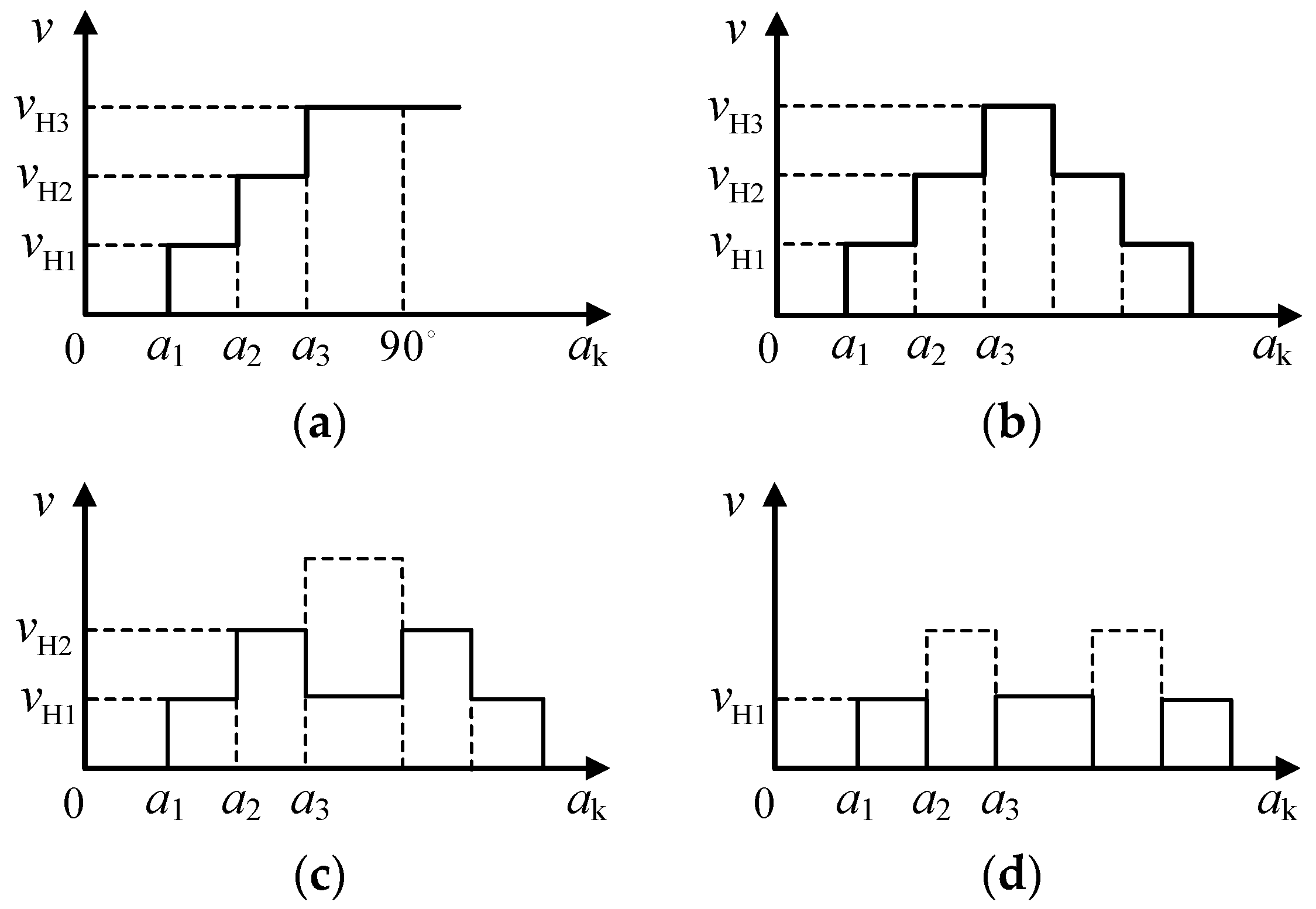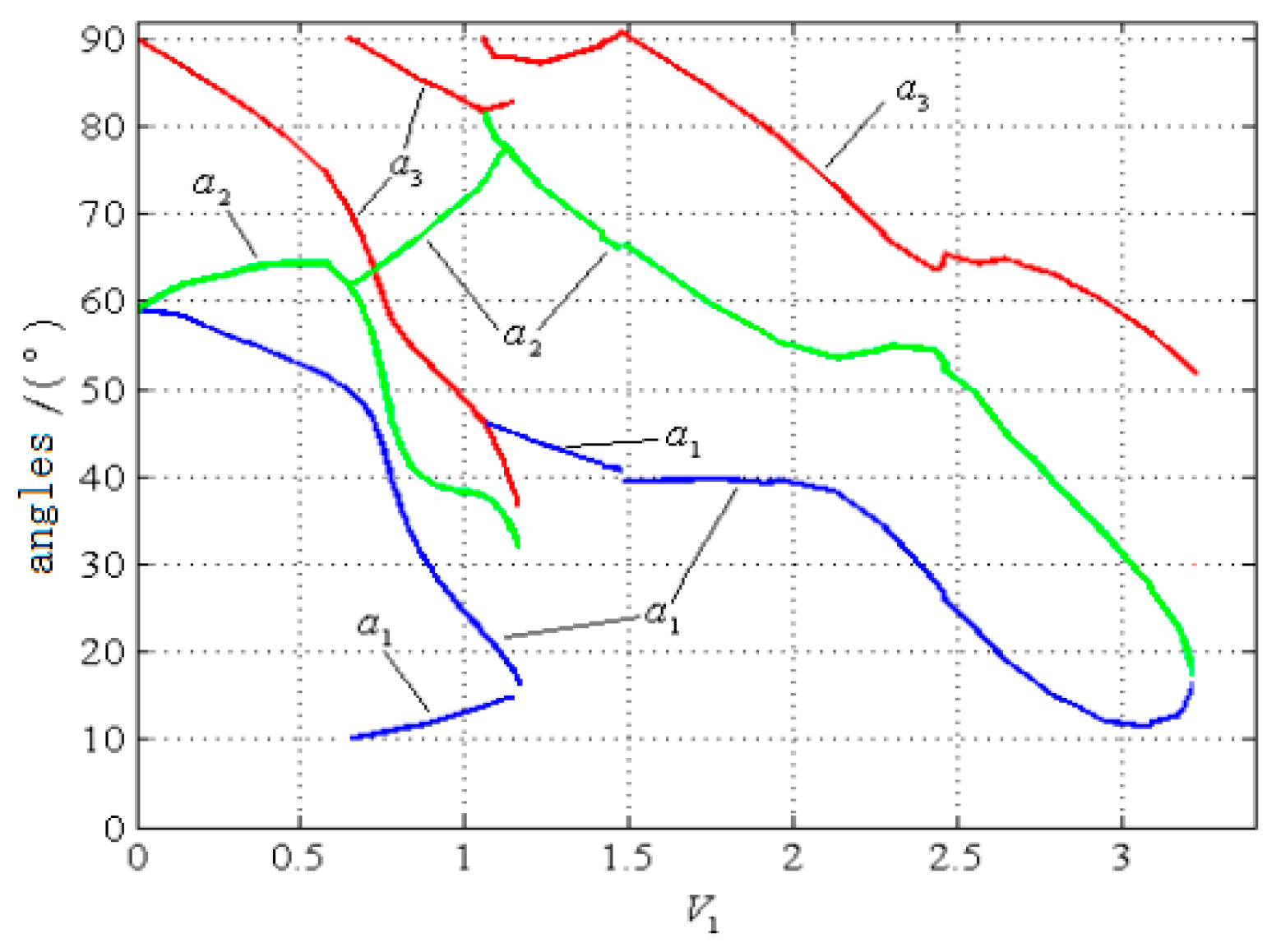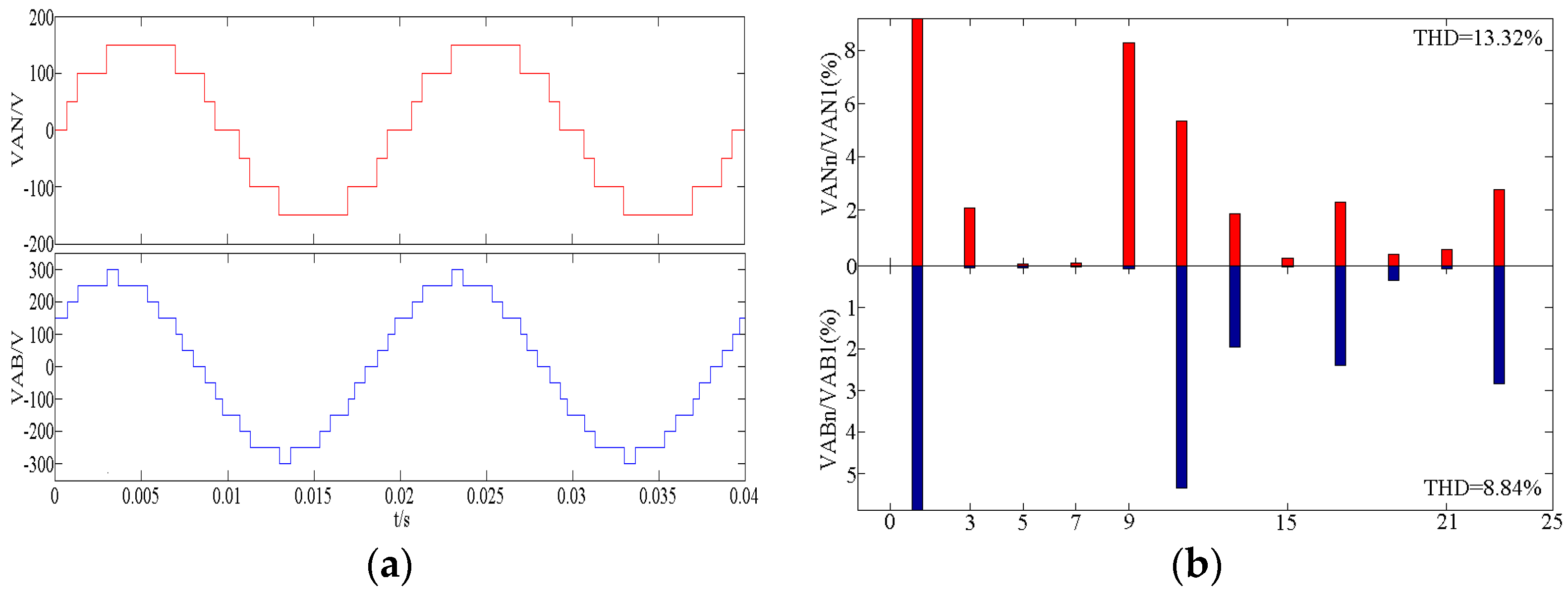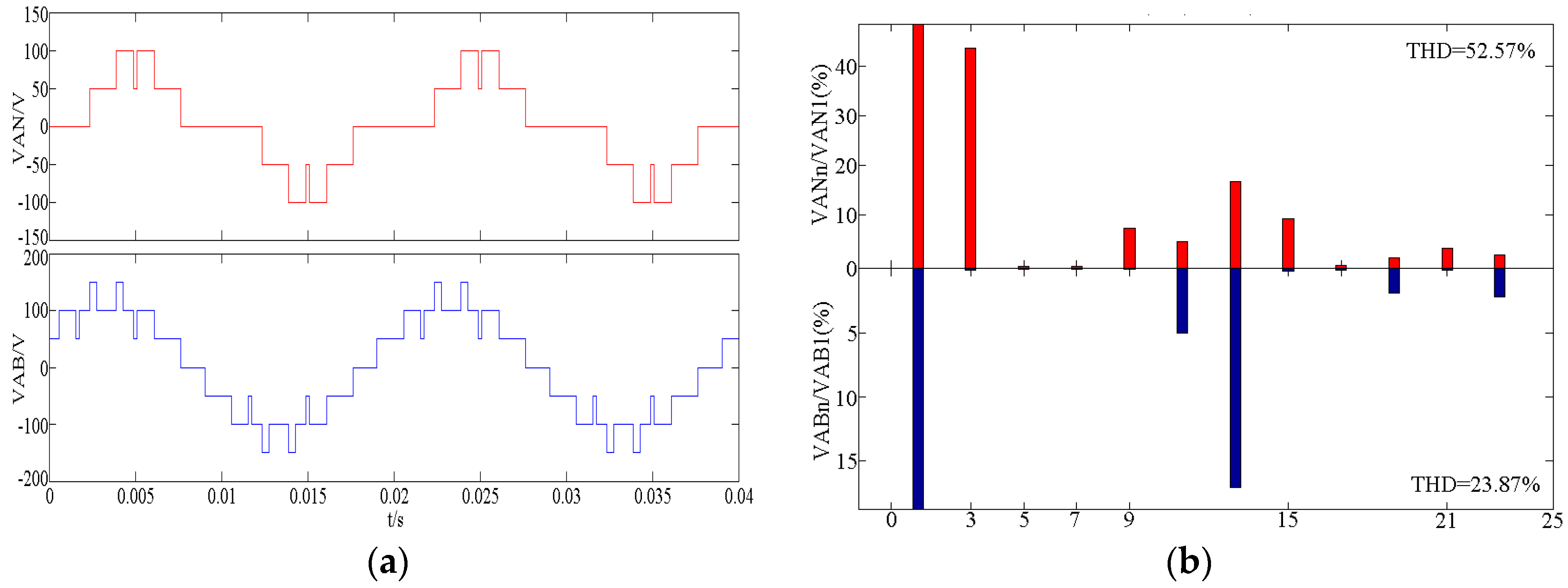1. Introduction
The cascaded H-bridge (CHB) multilevel inverter is one of the popular converter topologies used in high-power medium-voltage (MV) drives [
1]. It has many advantages, such as its high voltage level, low voltage change rate, and its easy modularization [
2]. The pulse width modulation schemes for multilevel inverters can be generally classified into carrier-modulated sine pulse width modulation (SPWM) [
3], voltage space vector pulse width modulation (SVPWM) [
4], and selected harmonics elimination pulse width modulation (SHEPWM) [
5,
6,
7]. The SHEPWM scheme has several distinct advantages, such as having a low switching frequency, high output quality, low switching losses, and high inverter efficiency. The core issue of the SHEPWM control is the solution of nonlinear equations of the multilevel inverter, including the selection of initial values and the selection of iterative algorithms. In addition, the traditional trapezoid wave modulation SHEPWM for multilevel inverter control technology is limited by the modulation index, which generally cannot randomly change from 0 to 1. When the modulation index is relatively low, the SHEPWM nonlinear equations may have no solutions.
At present, most papers use the Newtonian iterative method to solve nonlinear equations, but this needs to find the initial value, which is relatively close to the accurate value, in order to make the algorithm converge, otherwise the iterative algorithm is be convergent. The polynomial synthesis method and the power method are proposed to solve nonlinear equations in [
4,
5]. However. these methods are too complicated and need to be derived for different levels, which makes it hard for them to be widely used. The homotopic algorithm is applied to solve the SHEPWM nonlinear equations in [
7], which raises the rate of convergence of the iterative process to a certain extent. However, the dependence on the initial value of the iterative process is still strong and there is no guarantee that the iteration can be convergent. A SHEPWM function is proposed based on the Walsh functional transform in [
8] by analyzing the relationship between the Walsh domain and the Fourier domain, and by transforming the nonlinear transcendental equations of the Fourier domain into the Walsh function under the domain of the piecewise linear system of equations. The calculation steps of the conversion process are improved and the recursive methods used between the harmonic elimination angles and the fundamental wave voltage section amplitude are proposed in [
9,
10,
11,
12].
To obtain the initial value, the trial and error method is used in [
8]. If there is a lack of evidence when selecting the initial value, the efficiency of the iteration is low. Sometimes equations may also be divergent. The triangular carrier SPWM method is used to get the initial solution in [
9]. In fact, this is the method used to solve the reference sine function and a series of piecewise linear functions. However, the calculation process is very troublesome. The approach of Wu is introduced to find the solutions for the initial values of the SHEPWM nonlinear equations in [
10], which is complex and hard to achieve.
To expand the modulation index of SHEPWM for a multilevel inverter, the method of reducing a pulse to extend the modulation index to 0.2 is used in [
11]. However, the freedom degrees and the number of harmonics eliminated will be reduced at the same time. The polarity reverse method is proposed to expand the modulation index in [
12], however the energy consumption control of the DC link needs to be increased to solve the problem of the energy feedback caused by its structure. The six sections of the ladder-type wave switching model are proposed in [
13], but the problem of the energy feedback also exists and the working frequency of the switch cannot stay the same.
As it is easy to solve nonlinear equations by using Walsh functions and they have a low dependence on the initial solution, a kind of transformation method is proposed, for which the multilevel inverter modulation index of the multiband SHEPWM modulation scheme [
14] can be broadened and combined with Walsh functions. The SHEPWM voltage waveforms of the multilevel inverter in different waveform band modes are analyzed and the multiband SHEPWM solution model with modulation indexes ranging from high to low is established. Finally, the unity SHEPWM equations of the piecewise linear system of equations can be solved using the Walsh function transformation.
This paper is organized as follows: The harmonic elimination model of the multiband SHEPWM is presented in
Section 2.
Section 3 introduces the Walsh function. The Walsh function transform is proposed to solve the angle of the multiband equation in
Section 4. Simulations and experimental results are presented in
Section 5 and
Section 6, respectively, to validate the performance of the proposed method. Finally, the conclusions are summarized in
Section 7.
2. Harmonic Elimination Model for Multiband SHEPWM
The topology structure of the H-bridge cascaded seven-level inverters is shown in
Figure 1. It is composed of a series connection of three H-bridge cells. Each H-bridge unit is powered by a separate DC power supply. Assuming that the input voltages of the three H-bridge cells are
Vdc1 =
Vdc2 =
Vdc3 =
E, the corresponding output voltages of each cell are
VH1,
VH2,
VH3. The generated output voltage of each cell is composed of the three voltage levels +
E, −
E, and 0, using a different combination of the four switches.
Table 1 shows the output voltage of the inverter under different output functions. Where S
1, S
2 and S
3 are the output level function of H1, H2 and H2 respectively. It can be seen from the table that the phase voltage
VAN of the three-element CHB inverter canh1 have a total of seven levels of ±3E, ±2E, ±E, and 0. In order to avoid energy circulation, the output states of the opposite polarity of the output voltage of each unit are removed in
Table 1. It can be seen from the table that when the output levels of the phase voltage
VAN are ±2E and ±E, each unit has a redundant output state function.
The multiband SHEPWM multilevel inverter waveform is shown in
Figure 2.
The graph of the seven−level phase voltage is shown in
Figure 2a, which is transformed by a Fourier transform as follows:
where
Expanding and analyzing
bn in Equation (1) we get:
The switching angles denoted by
(in radians) are
. Here, E is the voltage value for each unit of dc;
bn is the harmonic coefficient;
pk is marked + 1 when it rises at the point of
and −1 when it decline. The graph of the half-wave symmetry waveform of the seven-level ladder-type modulation is shown in
Figure 2b, in which the output voltages of each unit H-bridge are
VH1,
VH2, and
VH3. According to Equation (3), a harmonic elimination of nonlinear equations can be established. There are no solutions when the modulation index is lower than 0.4, as the five- and seven-fold harmonics are eliminated by the numerical algorithm. According to the above situation, a multiband modulation scheme is proposed in this paper by broadening the index of modulation. The modulation index can be broadened as shown in
Figure 2c,d.
By observing the staircase waveform, it is easy to find that the waveform transformation rules between different wavebands are used to fold down the waveform with the dotted line at the top. The applicable modulation indexes shown in
Figure 2b to
Figure 2d for modulation modes A, B, and C are [0.4, 1], [0.3, 0.3], and [0, 0.3], respectively. The modulation index can be broadened to 0–1 according to the above multiband modulation method. The correct switch angles under different modulation indexes can be obtained by establishing SHEPWM nonlinear equations in accordance with the waveforms of different wavebands, for which the modulation index has different ranges.
3. Walsh Functions
The Walsh function is a standard orthogonal function system. It has only two values, 0 and 1, but the value of the function changes between 0 and 1, so the theoretical analysis is more complex than the trigonometric function. In recent years, due to the rapid development of new disciplines and technologies, Walsh function theory has been widely used in radar, communication, medicine, imaging, and other fields. The introduction of the Walsh function into the electrical field is of great significance.
The Walsh functions are a set of complete orthogonal function systems that can be expressed as Wal(n,t), where n is usually the zero crossing point (ZCP) number under time T of a certain order for the definition of Walsh functions, where t is the normalized time spacing of T.
The quarter-cycle waveform normalized by
Figure 2a is shown in
Figure 3, where T (0–1) is divided into 2
m uniform areas, c is the normalized value of θ
1, and the interval number of the rising edge is marked with N. Similar to Fourier expressions, the Walsh functions are obtained using the waveform transformed by the Walsh function, which are shown below:
Equation (4) is simplified according to the symmetry as follows:
In Equation (6),
is the coefficient of
meaning that the corresponding waveform of the Walsh functions is
f(t). A quarter cycle of the normalized three-level PWM waveform is shown in
Figure 2. According to
Figure 2, Equation (7) can be deduced as follows:
As seen in Equations (1) and (4), some transformations can be taken to convert the transcendental equations under the domain of the Fourier transform into piecewise linear equations under the domain of the Walsh function. According to the Equation (3), we can get:
Under the same angular frequency, Equation (6) can be developed under the domain of the Walsh function to infinity, Equation (8) can be made equivalent with it under the Fourier transform, then Equation (6) can be brought into Equation (9), and we can get:
Equation (11) is the Fourier coefficient of the (2
n−1) harmonic for the Walsh function
then we plug in Equation (10) into the deformation:
Equation (11) is complex to solve, while a nonrecursive formula of the Walsh function Fourier transformation is given in [
15,
16]. For
k = 2
i−1,
i = 1,2,3,…,
m = 4
n−3,
n = 1,2,3,…:
In which j = (−1)1/2 records only plus or minus of (−j)d when calculating, while the variable instructions of Equation (13) are as follows:
Record the order of the Walsh function as m, making its expressions for e binary;
Convert e as gray code g, the record the x bite of the gray code for gx;
M is the total number of g, while d is the total number of 1 contained in g.
4. Solving Equations
Summarizing Equation (11):
In this process, [b] is the harmonic coefficient matrix, which is replaced by [U] for simplification. The matrixes [B] and [F] are the Walsh transform matrix and Walsh coefficient matrix.
We assume that the harmonic coefficient Uk of the k time eliminated harmonic component is zero, which satisfies the fundamental current amplitude at the same time. We then establish a harmonic elimination system for linear equations and solve the switch angle, the calculation steps for which are shown as follows:
Determine the total interval number N according to the precision of the harmonic elimination, give a set of relatively accurate initial values, determine the interval after normalization, and serve the initial conditions;
According to interval number N and the harmonic number k, calculate the Walsh transform matrix [B];
According to interval number N and the determined initial conditions, calculate the Walsh coefficient matrix [F];
According to Equation (14), establish the piecewise linear system of equations;
Solve the piecewise linear system of equations and get the corresponding number of switch angles.
Taking the seven-level waveband A as an example, the accuracy of the interval number N is shown as 64 [
16], the initial switch angles for
a1,
a2, and
a3 are 11.52°, 28.728°, and 57.096°. The interval numbers of the switch angles are 3, 6, and 11, respectively. The scope of the initial angles is shown as:
For the seven-level inverter’s three-phase system, five and seven-fold harmonics are generally eliminated. The Walsh coefficient matrix [F] can be obtained by the selection of the initial conditions and by using Equation (7), as shown in
Table 2. The corresponding coefficient of the Walsh function is
Fw(4i−3), where
i = 1,2,3…, and using the interval number N and the eliminated harmonic number k, the Walsh transform matrix [B] can be obtained, as shown in
Table 3. As space is limited, only some of the data are shown.
Combined with Equation (14):
Assuming that the harmonic coefficients U
5 and U
7 are zero, according to Equation (16):
According to Equations (15) and (17), we get 1.4172 ≤ U1 ≤ 1.4523, which meets the fundamental current amplitude conditions. Thus, the first set of solutions can be obtained. Then, the limit value, which met Equation (17), should be substituted into Equation (16), and the other set of switch angles can be obtained. After determining the range, the process above can be repeated and another set of solutions can be obtained. All switch angles can also be obtained.
Taking the seven-level inverter multiband ladder-type modulation as an example, the switching angles for SHEPWM can be solved using Walsh transforms. The selected interval number N is 64 and the eliminated 5th and 7th harmonic are calculated in accordance with the above example. Along with the multiband modulation mode, as shown in
Figure 2, the harmonic elimination switch angles of A, B, and C mode can be obtained, as shown in
Table 4,
Table 5 and
Table 6.
The linear equations transformed by Walsh functions cannot be solved when the seven-level inverter modulation index of 64 under the C band mode is below 0.170, as shown in
Table 5. To solve this problem, the solution involving expanding the interval number is adopted, so that the interval number N is taken as 128 and the C band mode switch angles can be evaluated, as shown in
Table 7.
As is known, after the interval number N changes from 64 to 128, the number of modulation segments increases dramatically. To get a lower modulation index for the switch angles, the precision of the switch angles is improved as well, but the calculation is increased with the corresponding computation.
5. Simulation Result
Based on the data in the above tables, this paper draws the change track of the angle of the harmonic elimination switch with the amplitude of the fundamental voltage, as shown in
Figure 4.
It can be seen from
Figure 4 that the correct switching angle can be obtained for each band of the modulation index in the range of 0–1. Moreover, it can be found that there are multiple sets of switch angle trajectories in each cell near each switch band. These redundant switch angles can increase the flexibility of the switch angle selection and improve the control performance in the actual control.
To test and verify the correctness of the above theoretical analysis and the solving solution, MATLAB and SIMULINK software were used for the seven-level inverter of the multiband SHEPWM based on the Walsh function transform to build the model and do the experiment. The simulation parameters were as follows: the independent dc voltage source was 50; A, B, and C bands took fundamental voltage amplitude
U1 as 3.15, 1.32, and 1.0, respectively, when choosing the switch angles. The output voltage waveforms and spectrum distribution are shown in
Figure 5,
Figure 6 and
Figure 7.
Figure 5 shows the waveform of the output phase voltage V
AN and line voltage V
AB in the A band when the fundamental voltage amplitude is 3.15, along with the Fast Fourier Transform (FFT) analysis.
Here, VAN is the A phase voltage, VAB is the line voltage, VANi is the A phase voltage harmonic, VABi is the A phase line voltage harmonic, VAN1 is the fundamental wave of the A phase, and VABi is the fundamental wave of the line voltage between phase A and phase B.
According to
Figure 5a, it can be seen that the phase voltage V
AN is 7 levels and the line voltage V
AB is 13 levels, which conforms to the design of the A band. From
Figure 5b, it can be seen that the Total Harmonic Distortion (THD) of the phase voltage V
AN is 13.32%, in which the 5th and 7th harmonics are eliminated. The THD of the line voltage V
AB is 8.84%, in which the 3rd, 5th, and 7th harmonics are eliminated, which proves the correctness of the switch angle calculation. At the same time, a high-quality voltage waveform can be obtained under the SHEPWM modulation.
Figure 6 shows the waveform of the output phase voltage V
AN and the line voltage V
AB in the B band when the fundamental voltage amplitude is 1.32, along with the FFT analysis.
According to
Figure 6a, it can be seen that the phase voltage V
AN is 5 levels, while the line voltage V
AB is 7 levels, which conforms to the design of the B band. From
Figure 6b, it can be seen that the THD of the phase voltage V
AN is 52.57%, in which the 5th and 7th harmonics are eliminated. The THD of line voltage V
AB is 23.87%, in which the 3rd, 5th, and 7th harmonics are eliminated, which proves the correctness of the switch angle calculation.
Figure 7 shows the waveform of the output phase voltage V
AN and the line voltage V
AB in the C band when the fundamental voltage amplitude is 1.0, along with the FFT analysis.
As shown in the
Figure 7a, the phase voltage V
AN is 3 levels, while the line voltage V
AB is 5 levels, which conforms to the design of the C band. From
Figure 7b, it can be seen that the THD of phase voltage V
AN is 47.48%, in which the 5th and 7thharmonics are eliminated. The THD of line voltage V
AB is 32.66%, in which the 3rd, 5th, and 7th times harmonics are eliminated, which proves the correctness of the switch angle calculation.
As shown in
Figure 5,
Figure 6 and
Figure 7, the 5th and 7th harmonics have basically been eliminated, which can be proved using the control technology of the SHEPWM multilevel inverter based on the Walsh transform, combined with multiband modulation, which is feasible in this paper. Because of the limitation of the calculation accuracy and the precision of the numerical algorithm needed to solve the switch angles, the harmonic cannot be completely eliminated. Usually it will have a small amount of deviation, and the calculation of the accuracy of the switch angles under different modulation indexes is not the same.
In this paper, the effects on harmonic elimination under various modulations based on multilevel inverters have been studied, and 5th and 7th harmonic indexes have been listed. The amplitudes of 5th and 7th harmonics, which have been completely eliminated, theoretically are actually not zero, as shown in
Figure 8a. The 5th harmonic indexes based on 64 and 128 phase voltage interval schemes under the C band model are given in
Figure 8b.
As shown in the
Figure 8a, although the 5th and 7th harmonics have not been completely eliminated, there is a very small amount of error. The values are different under various modulation indexes. The errors indicate that the switch angles of the SHEPWM are not accurate, but they can be completely ignored in actual engineering control. From
Figure 8b, the harmonic indexes in the 128-interval scheme are lower than the 64-interval scheme overall. This proves that the larger the interval scheme that is selected, the more precise the switch angels are and the better harmonic elimination effect it has.
6. Experiment Verification
In order to prove the feasibility of the algorithm proposed above and the harmonic elimination effect in the practical engineering, an inverter experiment platform is set up, whose parameters are reported in
Table 8. An interface board is designed to do the isolated signal conditioning required for Analog to Digital Converter (ADC) module of a Digital Signal Processor(DSP)controller. The utilized processor is a TMS320F2812(Texas Instruments, Texas, USA) controller used to perform all necessary functions in the discrete time domain.
The output phase voltage V
AN of the inverter under the SHEPWM modulation when the modulation index is 0.75 and its spectrum are shown in
Figure 9a,b, respectively.
Figure 9c,d show the output phase voltage V
AN of the inverter when the modulation is 0.46 and its spectrum, respectively.
Figure 9e,f show the output phase voltage V
AN of the inverter when the modulation is 0.27 and its spectrum, respectively.
When the modulation index is 0.75, it corresponds to the SHEPWM modulation in the A band.
Figure 9a shows that the output phase voltage is 7 levels. In addition,
Figure 9b shows that the 5th and 7th harmonics are basically eliminated and the THD of the phase voltage V
AN is 34.9%.
When the modulation index is 0.46, it corresponds to the SHEPWM modulation in the B band.
Figure 9b shows that the output phase voltage is 5 levels. In addition,
Figure 9e shows that the 5thand 7th harmonics are basically eliminated and the THD of the phase voltage V
AN is 43.1%.
When the modulation index is 0.27, it corresponds to the SHEPWM modulation in the C band.
Figure 9c shows the output phase voltage is 3 levels. In addition,
Figure 9f shows that the 5th and 7th harmonics are basically eliminated and the THD of the phase voltage V
AN is 63.2%.
Overall, the correctness of the switch angle obtained by the multilevel inverter for the multiband SHEPWM control technology based on the Walsh function is proven. In addition, the multiband SHEPWM control technology of the multilevel inverter based on the Walsh function proposed in this paper can solve the problem of the limited modulation index in the specific harmonic elimination PWM technology effectively.















